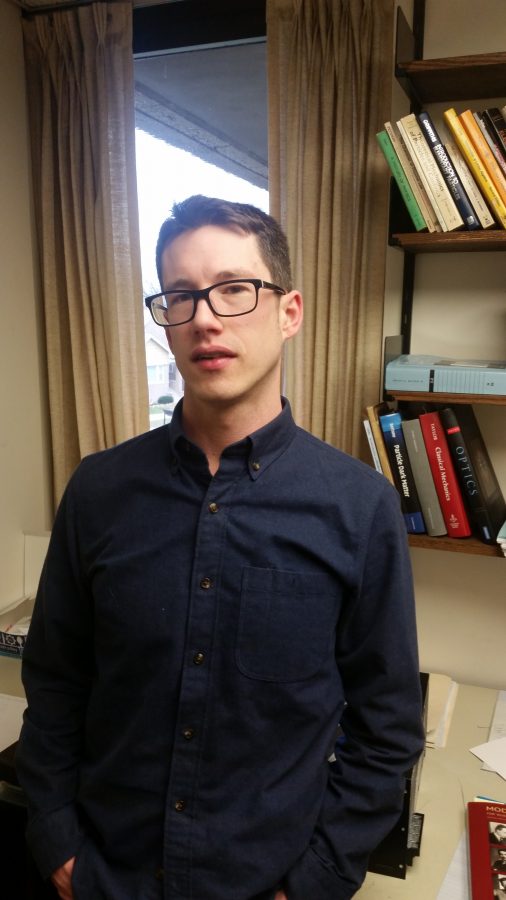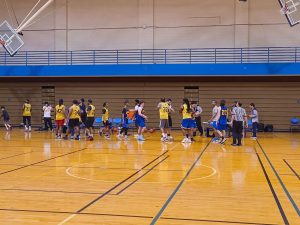Dark Matter and the PICO collaboration
Assistant Professor Orin Harris wants to bring a small dark matter chamber directly to NEIU’s physics department.
March 14, 2017
An NEIU physics professor is making his mission to research dark matter within our universe.
Matter in general is a substance that has mass and takes up space. Dark matter is a type that is invisible to the naked eye because it doesn’t interact with electromagnetic radiation. Scientists know dark matter exists due to how it interacts with other visible matter.
Nearly 85 percent of all matter in the universe is dark matter, explained Dr. Orin Harris, a researcher and NEIU physics professor with a collaboration project that formed from the merger of two parent organizations: PICASSO: Project In Canada to Search for Supersymmetric Objects and COUPP: Chicagoland Observatory for Underground Particle Physics.
The name PICO was formed by the first two letters of each organization’s name.
PICO formed in 2012 and their research on dark matter has recently been recorded as the “world’s best” limit in evidence of dark matter. Harris joined the PICO team in 2013.
Harris said the first time Sudbury Neutrino Observatory Lab (SNOLAB) put a bubble chamber deep underground was sometime back in 2007-2008. The reason that the experiments have to take place so deep underground is because too much radioactive interference from the surface would make dark matter detection nearly impossible.
“The radioactivity that is being created by cosmic rays is so much larger than the radioactivity that you expect to be created by dark matter,” said Dr. Carsten Krauss, lead scientist for the PICO-60 experiment and professor at the University of Alberta in Canada. “The problem with the surface is there’s so much natural radioactivity that it completely swamps our detectors.”
Among NEIU there are 17 other universities and organizations in collaboration with PICO and SNOLAB, some of which are Northwestern, University of Toronto, Université de Montréal, Pacific Northwest National Laboratories and several others from various states in the U.S. and Canada, including other countries abroad.
Since dark matter composes so much of the universe, the importance of these experiments seeking to greater understand what makes up the universe and world around us is great according to Harris.
Harris explained that the simplest way to differentiate among the various types of dark matter is by discriminating between two forms: spin-independent and spin-dependent interactions. The bubble chamber—which is used in the experiments conducted at an underground laboratory (approximately 6,800 feet) called SNOLAB in Sudbury, Ontario—is most sensitive to spin-dependent interactions.
“Spin” is a property of a particle and some particles have different sensitivities to spin than others. An example of this is xenon versus fluorine. Xenon has less spin than fluorine, therefore xenon would be a good candidate for a spin-independent interaction. There are also labs that use liquid xenon for such experiments to detect dark matter.
Krauss said there is very little known about dark matter and there are currently many theories on its possible properties, especially on whether it carries spin or not. Different approaches are used (spin-independent versus spin-dependent experiments) to be able to better understand this.
“For that type of dark matter we are the most sensitive in the world,” Harris said about PICO’s accomplishments in their dark matter experiments. “We currently have the largest operating bubble chamber, which is kind of neat.”
Harris said bubble chambers were commonly used by physicists in the ‘50s and ‘60s for particle detection for what is now part of the standard particle model. After a period of stagnancy, there has been resurgence in their use for research in the discovery for evidence of dark matter.
The reason bubble chambers first went out of style was because they weren’t fast enough anymore for particle detection but came back into popularity when it was discovered that for the purposes of dark matter detection, speed was an irrelevant factor.
Although there is no direct evidence of dark matter, since it has not been directly measured, there is strong evidence gathered over the years that supports its existence. “Once you can start seeing evidence in the laboratory for dark matter you can begin to measure its properties and those allow you to really start to understand exactly what it is,” Harris said.
The methods used in the experiments in observing the dark matter aren’t only about simply watching and recording the bubbles forming from the dark matter interactions but also the use of acoustics. “We actually listen to the sound of the bubbles as they form and that sound is actually different for dark matter and radioactive decays that occur in our detector,” Harris said.
The bubble chamber, PICO-60, which is their largest chamber, is filled with octafluoropropane, known as C3F8. This is a newer fluid than had been previously used. This fluid is superheated past its boiling point between 14 and 16 degrees centigrade and since the fluorine nucleus has a high degree of nuclear spin, this makes it most ideal for the detection of spin-dependent dark matter.
What happens in the experiment is that when the liquid is superheated, it causes a reaction called nuclear recoil where one single atom of fluorine is “kicked away,” which causes the bubble to form and depending on the acoustics measured the scientists are able to determine if it is being caused by dark matter.
Krauss said that the latest findings of the PICO-60 experiment — having the greatest recorded limit of dark matter — demonstrate that their technology and techniques work really well.
“This is really exciting for us because it allows us to get ready for a really large detector,” Krauss said.
Harris was also excited about his plans to build a smaller dark matter chamber for Northeastern Illinois University’s physics department that will be used to further support the research being conducted at SNOLAB by the PICO collaboration.
They would accomplish this by testing different types of fluids for the bubble chamber and different acoustic measuring devices. It won’t be used to directly measure or detect dark matter though, since that requires the experiments to take place very deep underground.











Ekene • Sep 27, 2021 at 5:17 pm
I think you did justice to what was addressed in your post. Thanks a lot. If you don’t mind, you can see my blog and tell me what you think about it.
Jerry • May 13, 2021 at 5:36 am
It’s nice to see good write up like this at least once in a while ??
I am so glad you took out some time away and spent time with your son, which is so important. We did the same, though were also busy working behind the scenes, doing up the ABC forum and the blog too, and would be starting off with a bang from tomorrow now.
I wish I had time to watch movies! But as my kids do, and we often wonder how safe they really are – the sites – we don’t allow them to download from a lot of them. I guess the ones you mentioned are all safe, so I would pass it on to them for sure.
Thanks for sharing it with us. Have a nice weekend ??. Appreciated at Waptrick
Check this out >>> FZ Movies
You Might Like Free Movies
https://www.makeoverarena.com/zamob-games-music-videos-tv-series-www-zamob-co-za/
https://tecreals.com/fzmovies/